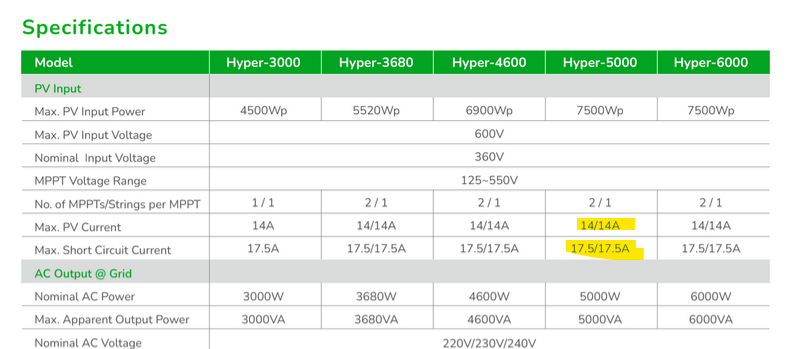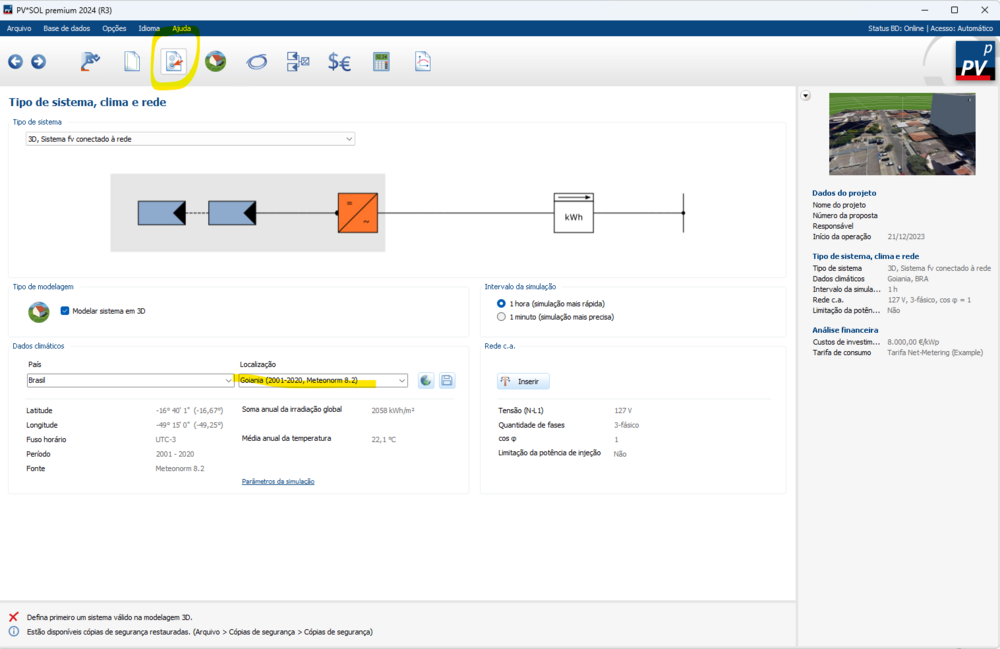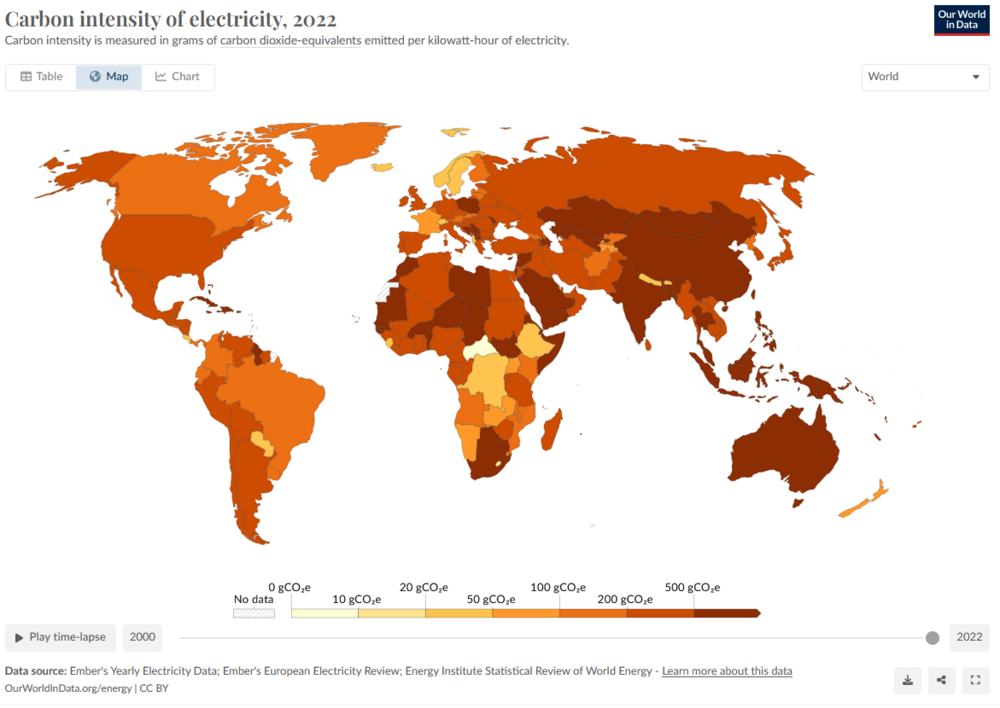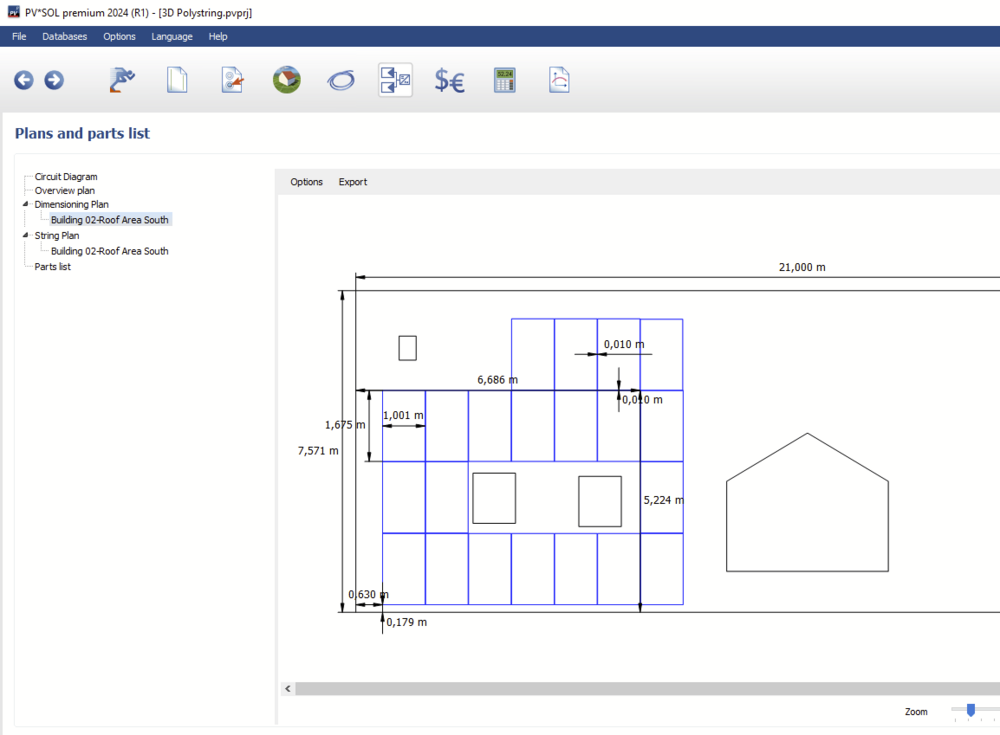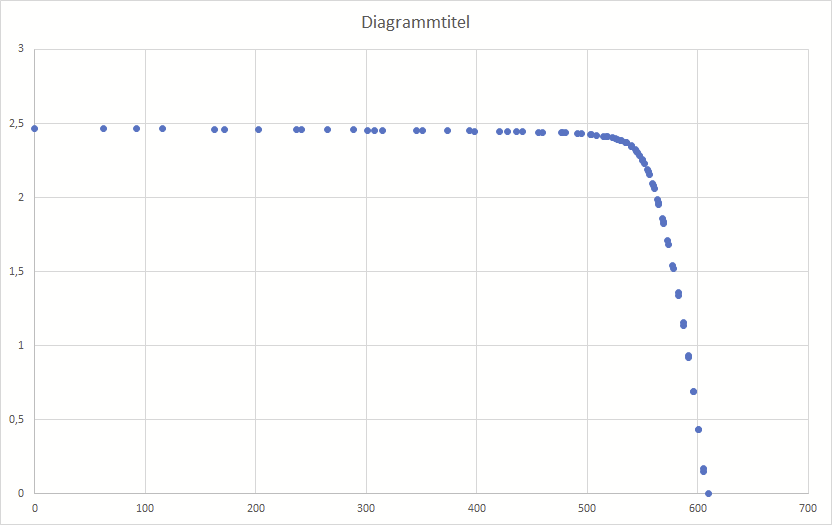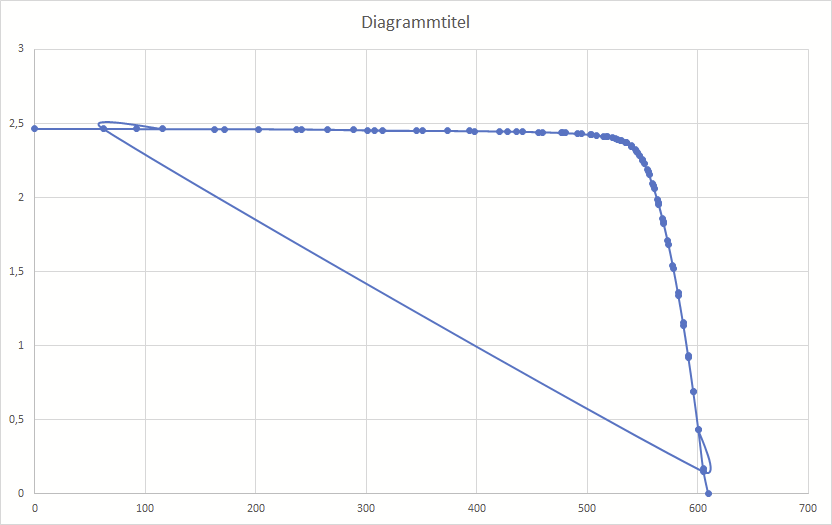-
Posts
1,822 -
Joined
-
Last visited
-
Days Won
169
Everything posted by developer_mh
-
Hi Keith, you are right, the max input current at inverter level should be the sum of the max input current values per MPP tracker. In the datasheet of the Hybrid-5000 it is stated that the 14 A are the max PV current. In total or per tracker? We don't know. It would be best if you contact the manufacturer and ask. When we divide the 5000 W by 360 V, we get a "nominal current" at inverter level of 13.9 A. So I personally doubt that the max current at inverter level is 14 A. I guess it is 28 A, whereas it is 14 A at MPP tracker level. I will forward this to our database team as well so that they can have a look. Kind regards, Martin
-

Fehlermeldung beim Start "Die Datei.... kann nicht geladen werden"
developer_mh replied to Ralf's topic in PV*SOL
Hallo Bell Inchen, wir sind ja bereits in Kontakt über den technischen Support. Wenn wir eine Lösung gefunden haben, können wir das ja hier posten, damit andere eventuell Betroffene auch davon profitieren können. Viele Grüße, Martin -
Hallo Eisenmann Photovoltaik, danke für die Anfrage. Wann genau wir dieses Feature so anbieten können, ist derzeit nicht absehbar. Wir halten es aber ebenfalls für ein wichtiges Feature und haben es auch bereits auf unserer Liste. Beste Grüße, Martin
-

Simulation einer PV-Anlage auf einem Gründach
developer_mh replied to theblackman7800's topic in PV*SOL
Hallo Gabriel, was genau soll denn bei dem Gründach simuliert werden? So etwas wie Pflanzenwachstum oder Temperatur- und Feuchtigkeitsregulierung durch das Dach kann nicht simuliert werden. Aber die PV-Anlage auf dem Dach kann natürlich simuliert werden, keine Frage. Beste Grüße, Martin -

Fehlende Textur nach 3D-Modell import mit DroneDeploy
developer_mh replied to Krys's topic in PV*SOL
Hallo Krys, sorry für die späte Rückmeldung. Leider können wir ohne das konkrete 3D Modell keine zuverlässliche Angabe zu den Gründen machen. Und auch, wenn wir das Modell bekommen, ist leider nicht gesagt, dass wir die Ursache herausfinden. Die entstehenden 3D Modelle können allerlei unterschiedliche Eigenschaften aufweisen, die dann zu solchen Artefakten führen. Du kannst das Modell aber mal dem technischem Support schicken, manchmal können sie sehen, was los ist: https://valentin-software.com/support/technischer-support/ Beste Grüße, Martin -
Hallo diwiro, danke für das Teilen des Workarounds mit den anderen Usern, das hilft bestimmt weiter. Ja, das ist ganz richtig. Wir sind daher auch dabei, die 3D Umgebung von grund auf neu zu entwickeln. Hier haben sich so viele neue Feature-Wünsche und komplexe Bugs angesammelt, dass sie mit der jetzigen Codebase nicht mehr (in einem angemessenen Zeitraum) zu beheben sind. Angefangen beim fehlenden Undo, über die besagte Belegungsgrenze an virtuellen Dachstößen bis hin zu Performance- und Arbeitsspeicher-Problemen. In der Summe macht es so für uns und vor allem unsere Kunden viel mehr Sinn, die ganze 3D Umgebung auf einen modernen Stand zu heben. Das ist eine Jahrhundertbaustelle, wir arbeiten mit Hochdruck daran, aber trotzdem braucht es einfach seine Zeit. Obwohl die Neuentwicklung einen Großteil unserer Entwickler-Kapazität frisst, versuchen wir trotzdem, in der jetzigen 3D Umgebung Bugs zu fixen und hier und da sogar ein neues Feature zu implementieren. Größere Fixes oder Features, die einen kompletten Umbau des Codes erfordern würden, können aber natürlich nicht mehr erfolgen. Das tut uns natürlich leid zu hören. Wir tun jedenfalls unser Bestes, um unseren Kunden eine Software anzubieten, die sie möglichst gut bei der Arbeit unterstützt. Es ist ja prinzipiell bei der Software-Entwicklung so, zumindest bei Software, die sich mit einer aktuellen, sich ständig weiterentwickelnden Technologie wie der Solartechnik beschäftigt: Egal, in welche Richtung man schaut, es gibt zu jedem Teil-Bereich in der Software hunderte Kundenwünsche. Die Wunschlisten hier im Forum sind nur ein kleiner Teil davon. Da liegt es in der Natur der Sache, dass nicht jedes Feature, dass sich Kunde A wünscht, umgesetzt werden kann. Wir bitten daher um Verständnis und wünschen uns, dass Sie uns weiter als Kunde gewogen bleiben. Beste Grüße, Martin
-

setting up PV*Sol for distibution through Microsoft Intune.
developer_mh replied to Admincs's topic in PV*SOL
This is great, thanks a lot, Valintune! I am sure it will be helpful for a lot of other users. One important point though: Photoplan does not need to be installed separately, it is now part of the standard PV*SOL installation (since 2024 R1). Even if you install PhotoPlan from the sources that you mentioned, a current version of PV*SOL will not use it, but will use the Photoplan executables and dlls inside C:\Program Files (x86)\Valentin EnergieSoftware\PVSOL premium 2024\Bin\Photoplan1.2- 11 replies
-
- unattended installation
- software distribution
- (and 2 more)
-
Hi dekay, this is absolutely reasonable. The 4% that you see in the 3D environment is the frequency of direct shadows on the modules, not the reduction of energy yield per year. It serves more as an indicator whether or not a module receives shadow. The impact on the energy yield per year depends on many other factors, e.g.: How are the modules interconnected? When does the shadow occur? How high is the direct and diffuse component of the solar irradiance at that moment This can only be determined in the energy simulation, after which you see the results that you showed us here. On our help pages you will find some more detail about the calculation of shadows, the effect of shadows on PV modules and PV fields and much more: https://help.valentin-software.com/pvsol/en/calculation/irradiation/ https://help.valentin-software.com/pvsol/en/calculation/pv-modules/ https://help.valentin-software.com/pvsol/en/calculation/pv-field/ Hope that helps, kind regards, Martin
-
Dear José Carlos, I guess what you experience there is that you have selected the location on the maps in the 3D environment, but perhaps not as climate data? Please close the 3D environment (you can adopt all data, if you wish), go back to the main application, head to the page "Tipo de sistema, clima e rede", and select the correct location: Then, when you enter 3D, the shadows are displayed correctly. Kind regards, Martin
-
Dear all, I'd like to share an interesting website I found recently where you can look up the specific CO2 emissions per country on a map: https://ourworldindata.org/grapher/carbon-intensity-electricity This was really a very rough estimate, by just diving the CO2 emissions by the electricity consumption, 37.5 Mt / 133.2 TWh = 282 g/kWh. This calculus does take into account a whole bunch of factors and actually we should forget that I even did that calculation We should look it up on the above website instead. Kind regards, Martin
-
Hi Asgar Kappel Skau, when you have a normal PV system that is connected to the grid, and the house consumption also connected to the grid, you can just choose a from-grid tariff and a feed-in tariff. You don't have to modify the tariffs. The PV energy that is generated is first used by the consumption in the house. If there is more PV energy than consumption, the rest of the PV energy is fed into the grid and you get paid for that with the price per kWh that is defined in the feed-in tariff. If there is more consumption than PV energy, the rest of the consumption energy has to be covered by the grid, and you will have to pay for it according to the from-grid tariff. "The price of electricity sold to third party" is something else that doesn't matter here in your case. It is only applicable if you have no tariff selected or if the selected tariff is not valid anymore. See here for more details: Hope that helps, best regards, Martin
-
Hi Luís, thank you for the project file. The reason for the error is the PV module that was created by a user. It has a relative efficiency in low light of over 376%: In future releases it won't be possible to enter data that lead to a relative efficiency of over 120%. And a general suggestion to users creating their own PV module data is to use the standard low light performance check box. This ensures that nothing can go wrong. Hope that helps, best regards, Martin
-
oh, thank you for the hint! Somehow we do not get noticed when our inbox is full. Should work now again
-

questions - assembly system, bifacial module, dimensions
developer_mh replied to Go green BG's topic in PV*SOL
Hi Go green BG, thank you for your questions and the screenshots. You choose to create a copy and then see all the details in the edit dialog. Then choose cancel. I will forward this request to our database team. If you create your own PV modules e.g. by copying existing ones and you don't know the low light parameters, just choose "standard" Yes, the module dimensions are displayed in the dimensioning plan, and are also listed in the PV module datasheet table Hope that helps, kind regards, Martin -
Hi Luís, Is there a project file that you wanted to attach? Without a project file it will be impossible to answer your question, I guess. Kind regards, Martin
-
Hi Karina Suharevska, this message indicates that you have too much wall objects in your scene. You could try to remove some unnecessary objects or perhaps combine several wall objects into one. If you want you can send over the project file so that we can have a look. You can send it to our technical support team here: https://valentin-software.com/en/support/technical-support/ Hope that helps, kind regards, Martin
-
HI Jakubson, this is a feature that will come in the next major version, PV*SOL premium 2024 R1. Right now, with 2023 R7, the only possibility is to define a inverter configuration with 4 times the Solax X3-Hybrid-15kW, and then connect the batteries to them and set the amount to 4 as well. But this only works if you have a 2D project or a 3D project without shadows. Hope that helps, kind regards, Martin
- 1 reply
-
- 1
-

-

Polystring zeichnet diagonale in Kennlinien Diagramm der Strings
developer_mh replied to deafsquad's topic in PV*SOL
Hallo deafsquad, danke für die Projektdatei. Es handelt sich wohl um einen Darstellungsfehler, bzw werden einige Punkte auf der Kennlinie nicht ordentlich sortiert. Wenn man mit Rechtsklick auf das Diagramm geht und sich die Punkte in Excel darstellt, sieht man, dass alles in Ordnung ist: Wenn man dann aber die Punkte mit Linien verbindet, tritt das Problem hervor: Die Kennlinie ist also korrekt, nur leider in der Darstellung falsch mit Linien verbunden. Danke fürs Melden! Wir schauen uns das mal an und setzen es auf unsere Todo-Liste. Beste Grüße, Martin -
Hi Luís, yes, sure, you can have P90 or P70 or anything you want. Have a look here: https://help.valentin-software.com/pvsol/en/pages/financial-analysis/bankability/ Note that this feature only works for PV system types without electrical appliances. Kind regards, Martin
-
Hi Philip Gabriel, it is not possible to rotate an imported 3D model by 45° in PV*SOL, I am afraid. You would have to rotate it in Agisoft beforehand or check the obj export parameters. Hope that helps, kind regards, Martin
-
Hallo deafsquad, die Hersteller tragen die Werte bei uns eigenhändig ein, da kann der Wirkungsgrad-Wunsch schon mal Mutter der Daten sein, je nachdem wie marketinglastig der jeweilige Mitarbeiter denkt. Wir werden diesen Eintrag bei Sofar melden und sie bitten, ihn gegebenenfalls zu korrigieren. Vielen Dank und beste Grüße, Martin
-

Polystring zeichnet diagonale in Kennlinien Diagramm der Strings
developer_mh replied to deafsquad's topic in PV*SOL
Hallo deafsquad, nein, das ist auf jeden Fall keine Absicht. Da wäre es hilfreich, die Projektdatei zu bekommen, damit ich mal reinschauen kann. Gerne hier im Forum als private Nachricht, danke. Viele Grüße, Martin -
Hi Jan, Thank you for reaching out and sharing your question with us. Unfortunately, the current configuration process does not support the addition of module arrays without reconfiguring the current configuration. Kind regards, Martin
-

"The circuit diagram could not be created"
developer_mh replied to Ing. Vojtech Vyborny's topic in PV*SOL
Hi michalmitro, could you contact our technical support team, please? Along with your customer number and your log files, so that they can help you out. Most likely it is an issue with a path or directory that is not found or access privileges are missing or so. https://valentin-software.com/en/support/technical-support/ Kind regards, Martin


